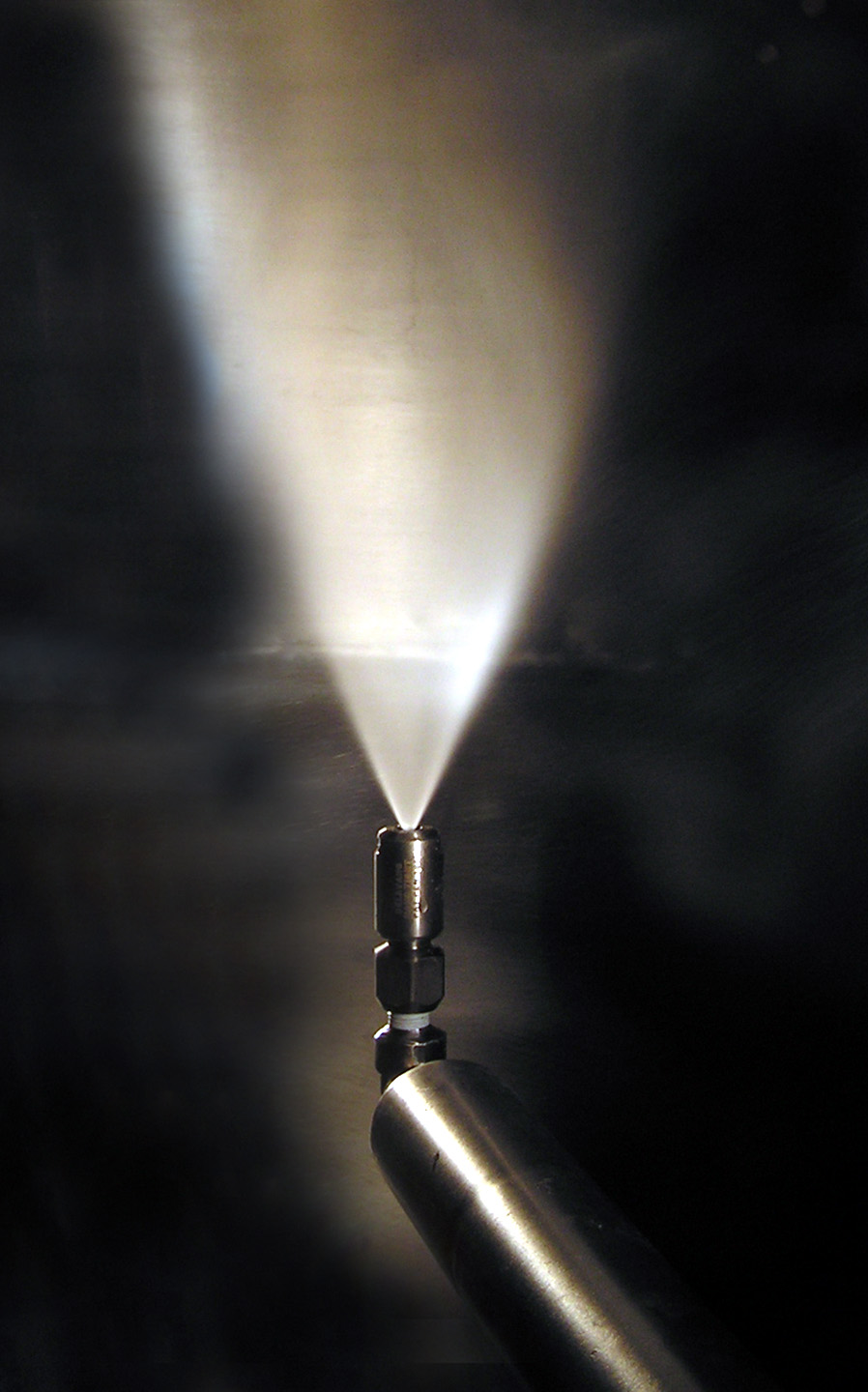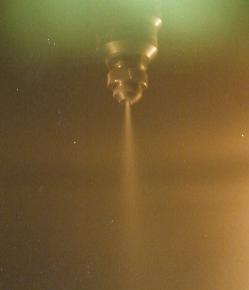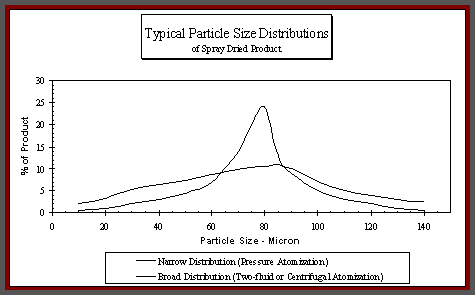ATOMIZATION
Producing
droplets of specific size and surface area by atomization
is the most critical step in the spray drying process.
The degree of atomization, under a set of spray drying conditions,
controls the drying rate, and therefore the required particle
residence time, and therefore the spray dryer size. All of the
atomizing techniques can give good average particle size
control, but there are major differences in the particle size
distribution created. The most commonly employed
atomization techniques are:
Pressure Nozzle Atomization
 |
 |
Pressure Nozzle |
- A
spray is created by forcing the fluid through an orifice.
The energy required to overcome the pressure drop is
supplied by the spray dryer feed pump.
- The
narrowest particle size distribution is possible with this
technique. Must be used when minimization of
“fines” is important to the product.
- The average particle size produced, for a given feed, is
a function of the flow per nozzle and the spraying pressure.
-
Spraying pressure depends on feed characteristics and
desired particle size, and can range from 300 to 3,000 psig.
- The
most energy efficient of the atomization techniques.
- Requires a positive displacement, high pressure feed
pump, such as a plunger pump or a piston/diaphragm pump.
- Requires
routine changing of the nozzle internal pieces, usually made of
tungsten carbide. Changing schedule depends upon the
application.
- Requires a minimum of approximately 0.10 GPM feed rate,
depending upon the size of un-dissolved particles in the
dryer feed, due to potential plugging with the small orifice
required.
- With
multiple nozzle spray dryers, a problem with one nozzle does not
shut operations down.
- Control of spray dryer wall buildup can be achieved
through variations of the spray angle.
Two-Fluid Nozzle Atomization
 |
 |
Two-Fluid Nozzle |
- A spray is created by contacting two fluids, the feed and a
compressed gas. The atomization energy is provided
by the compressed gas, usually air. The contact can
be internal or external to the nozzle.
- A broader particle size distribution is generated.
- The average particle size produced for a given spray
dryer feed is
primarily a function of the feed flow per nozzle, and the
compressed gas rate and pressure.
- The least energy efficient of the atomization techniques.
- Useful for making extremely fine particles (10-30 micron) because
of relatively high wear resistance. Also for the small
flow rates typically found in pilot scale dryers.
- Requires periodic changing of the air and liquid caps.
- Can typically use any type of spray dryer feed pump.
- Control of the spray angle is limited.
Centrifugal Atomization
- A spray is created by passing the fluid across or through a
rotating wheel or disk. The energy required for
atomization is supplied by the atomizer motor.
- A broader particle size distribution is typically generated.
- The average particle size for most products is limited
to under 100 micron due to wall build up issues.
- The average particle size produced for a given feed is
primarily a function of the diameter and RPM of the wheel.
- Requires relatively high gas inlet velocity to control wall
buildup, which can increase the amount of fines
produced.
- Can generally be run for longer periods of time without
routine maintenance.
- Usually the most resistant to wear. Requires periodic
changing of wheel inserts, usually made of tungsten
carbide.
- Control of wall buildup is minimal, due to direction of spray
(horizontal) and broad particle size distribution, forcing
the dryer to be relatively large in diameter.
- Capital cost of the atomizer is typically high.
Comparatively larger diameter spray dryer can increase capital
cost. As with any high speed rotating machine,
maintenance costs are high. Design of dryer roof and
atomizer support add to fabrication cost.
- A problem with the atomizer will shut down spray drying operations.
Particle Size Distribution Comparison

Atomization Energy Example Comparison
|
(Based on Atomizing 10 GPM of Feed
to 70 Micron Droplets)
- Pressure Nozzle: Feed Pump @ 1200 psig = 10 HP
Total
- Centrifugal Atomizer @ 9000 RPM @ 25 HP,
Feed Pump @ 30 psig @ 3 HP = 28 HP Total
- Two-fluid Nozzle: 180 SCFM Compressed Air @ 80 psig
@ 30 HP, Feed Pump @ 80 psig @ 5 HP = 35 HP Total
|
Mesh to Micron Conversion

Back to Top
|
